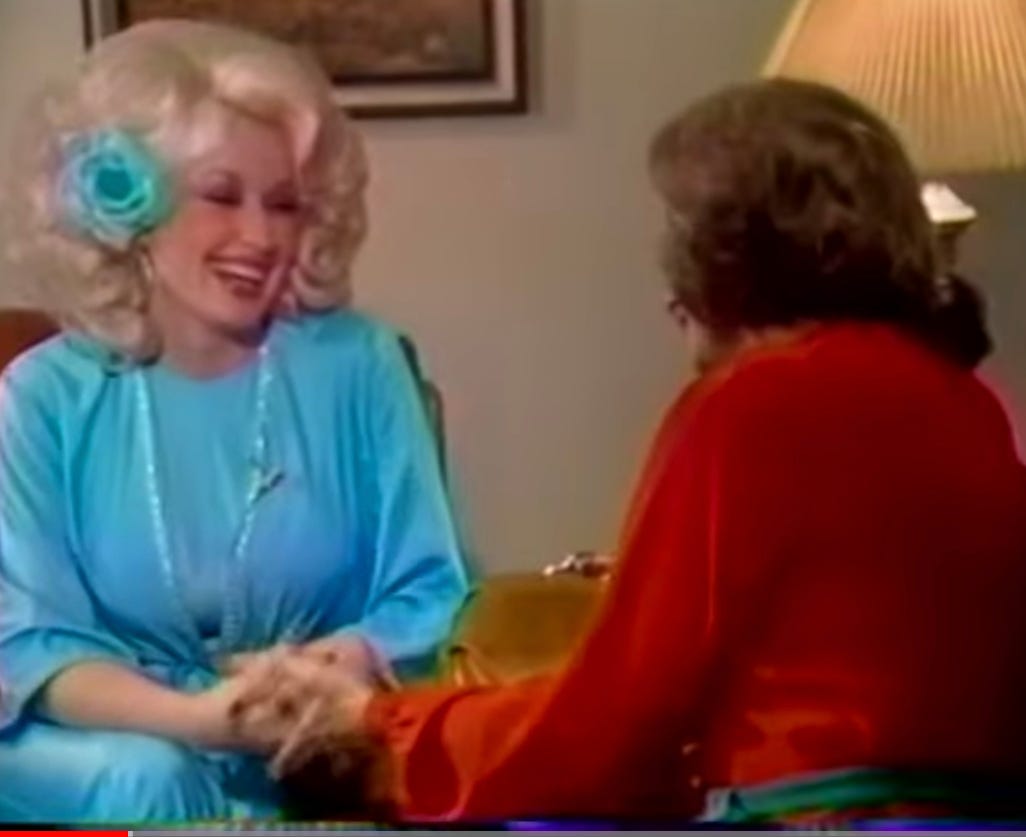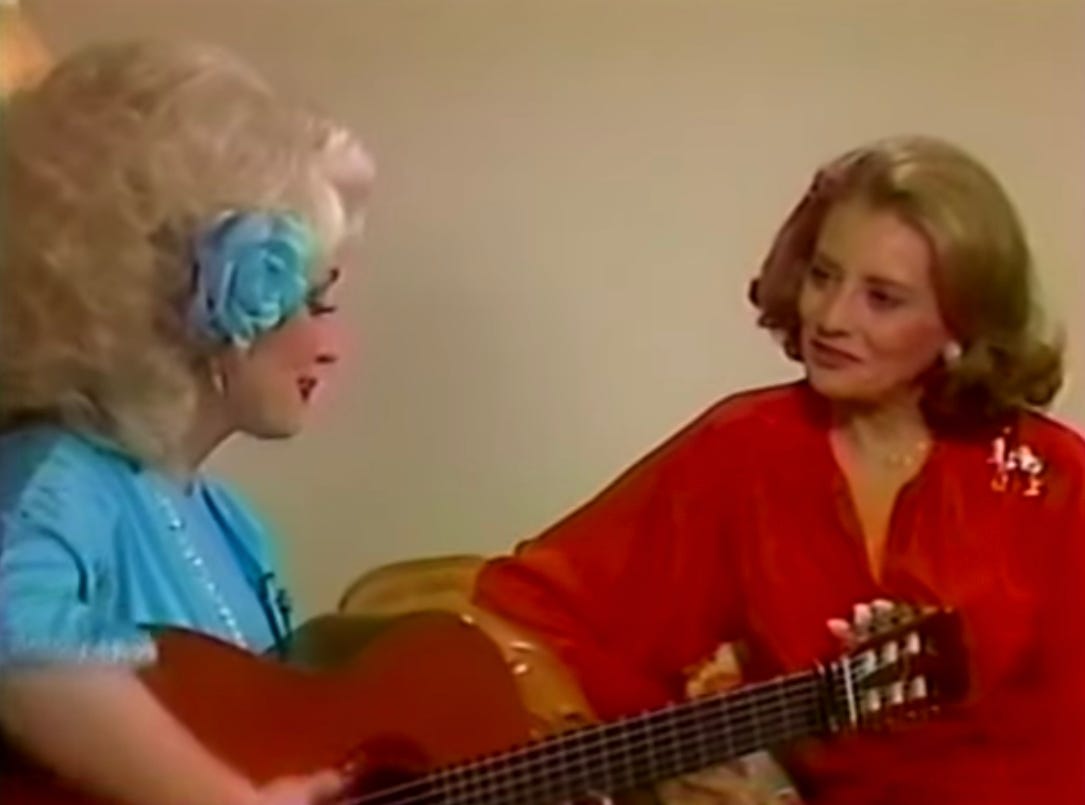Lesson 4: How Dolly Parton turned Barbara Walters from a critic into an admirer in a made-for-TV leadership "masterclass"
Strong leaders know two things: who they are and why they do what they do.
Why?
Because on those two points, strong leaders will be questioned and challenged. And when they are, they need to be ready.
Last time in The School of Dolly, we studied how Dolly Parton responds to criticism. We heard her describe how, despite the sting of a harsh word in response to something she’s created and shared, she chooses to listen and to learn, turning criticism into personal power.
In this class and at least one more in the weeks to come, we’ll listen to another interview—a 1977 broadcast with Barbara Walters who, in the introduction to the TV interview, said, “With her wild wigs and outrageous figure, Dolly Parton may be a Country Music caricature, but it’s of her own design. Behind it all is a savvy businesswoman and a prolific songwriter.”
The interview that followed has become a favorite among fans of our esteemed Professor who still marvel at the ability of the then 31-year-old to stand up to hard and, according to some who’ve seen it, nasty questions ranging from Parton’s childhood, her take on negative Appalachian stereotypes (specifically - hillbilly), her flamboyant image (at that time), rumors about wigs and chest size, and whether people should take her seriously despite her appearance and demeanor.
Much has been written about that 1977 interview, about the ways Parton “shut down” Walters, conducting a primetime TV masterclass and revealing herself to be an interview “ninja”.
By the way, she is. I’ve interviewed her four times, been in a live setting with her in which she’s taken unplanned questions, and watched her be interviewed by others for many years. She’s NEVER off.
But I think the 1977 interview is worthy of an examination through the lens of leadership.
I recently watched the full interview on Youtube intent upon finding early indicators how one of the planet’s most successful business and philanthropic leaders handled criticism and hard questions long before she achieved her current iconic status. And that’s important. In 1977, Dolly was a Country Music star. She had not yet emerged as the global entertainment and philanthropic icon that she is today.
I believe the ‘77 interview reveals a young person with dreams of superstardom (“I could get away with less, but I want more,” she said) and a willingness to be transparent about it and about her past, her present, and her future aspirations. There’s no hiding - just honesty.
The clip begins with Dolly showing Walters around her tour bus, proudly pointing out the couch that turns into a bed and the compact closets where she keeps her wigs and costumes which, by the way, she said she washed herself in a motel sink. “And they’re wrinkle-free,” she said proudly. “I don’t have to iron them and that works out good for me because that saves a lot on the cleanin’ bills.”
Pause. Dolly does her own motel sink laundry? That kind of make sense in a modern context because it’s on brand with the down-home keep-it-real persona that shines through the glitz and glamour. Today, we know she’s real. But this was 1977 when Parton wasn’t widely known outside the context of Country Music. Back then, she was still working to break through to the next level of stardom and business success. Back then, it was a risk to be so open and honest.
Dolly didn’t seem to care.
But why? Press on.
Cut to a shot of Dolly on a couch sitting beside Barbara Walters, the journalist’s arm resting on the back of the cushions, her head turned as if amused, and a smile that seems to say, “I’ve got you right where I want you.”
Most people - even veterans of the hard-hitting TV chat shows - would have been tempted to lose bladder control at that moment if they were in Dolly’s seat.
But not Dolly. There she is, strumming a guitar and singing “Coat of Many Colors,” her lump-in-the-throat inducing biographical ballad of poverty and pride and taunting bullies ridiculing her handmade coat of fabric scraps lovingly stitched by her Mother.
At one point, Dolly looks into the eyes of her inquisitor, the probing millionaire journalist who’d dined with kings and verbally sparred with world leaders, and sang-spoke (a unique Dolly technique that breaks the thread of lyrical phrases with non-singing verses laced effortlessly into a song), “It’s true, we had no money. But I was rich as I could be in my coat of many colors that Momma made for me.”
Song stops.
Walters doesn’t linger: “Tell me about your childhood.” Fair question after that particular song which was released six years before the interview in 1971.
Parton proceeds to bare all, telling about growing up in a big family along the Pigeon River in Sevier County, Tennessee poor as dirt.
Walters: “Were you a hillbilly?”
Pause. Class, if you wanted to offend someone from Appalachia in the 1970’s, you would have just dropped the H word. It was a sure way to lose a friend. Now, not so much. We’ve learned to be more like Dolly and embrace it.
Parton just laughs and volleys back saying she would have kicked Walters shins had she called her a hillbilly back when they were little girls because, “we were very proud people, people with a lot of class. It was country class, but a great deal of class. Most of my people were not that educated. But they were very very intelligent. Good common sense. Horse sense, we called it.”
At this moment, the vast majority of people with generational roots in Appalachia are rising to their feet in a roar of ‘YES! That’s US!” Parton’s description of her own family pulls back the curtain to reveal the failure of the American “hillbilly” stereotype which inaccurately equates poor and rural as classless and dumb.
Walters isn’t deterred. In fact, she doubles down with a series of questions about Parton’s appearance, questions that truly stunned me as I listened in 2023 (I missed the ‘77 broadcast; I was only 5!).
And then - the worst.
“Did you look like this when you were a kid?” Walters asked. Then she presses further, motioning to Parton’s chest while inquiring, “Did you have ‘this’ about you?”
Ears are now throbbing with discomfort.
Dolly doesn’t seem to care. Instead, she disarms us, Walters, and the listening audience while rapidly distilling the vagueness of Walter’s awkward question. “Do you mean my fuller figure?” And then with a laugh, Dolly side comments, “Yea, I thought that’s what you meant.”
Walters presses on saying, “You’re very beautiful. You don’t have to wear the blonde wigs. You don’t need to wear the “extreme” clothes, right?”
Condescension veiled as flattery? Again, Dolly doesn’t seem to care. Instead, with a smile, she drops a bomb. “I would never stoop so low as to be fashionable. That’s the easiest thing in the world to be.”
“I’m very real where it counts, and that’s inside as far as my outlook on life as far as the way I care about people and care about myself.”
That’s leadership.
That’s knowing who you are.
That’s signaling to anyone who’ll listen that you are to be believed.
I contend that this knowledge is what sustained Parton through the difficult decades to come. It was the foundation of her much talked about “dreams” that eventually would lead to the creation of an entertainment empire, a global charity that’s delivered millions of free books to children and one of the most beloved personal and business brands on the planet.
I’ve read that Dolly was warned not to do the interview but went on to be glad that she did. Walters in her decades-later introduction to the retrospective broadcast, right off the bat signals her love of her former target...um…guest.
“I don’t know exactly why, but Dolly Parton and I hit it off right from the start,” Walter said, the lens on a hard “soft focus” that became the broadcaster’s trademark in later years. “I was crazy about her - still am.”
“If any performer ever knew where she was going and how best to get there, it was Dolly,” Walters admits.
Not bad for a hillbilly.
Next class, we’ll continue picking apart the interview with a focus on how Professor P’s response demonstrates the power of knowing “why” you do what you do. It’s that knowledge that equips leaders for questions and criticism that will come to anyone with the courage to step out, dream big, and lead.






Love this one, Josh! I remember this interview…as I was older than 5! LOL. My Mom was a big fan of Dolly’s as I am. We watched that and was so proud! We knew right then that she was going to hold her own with anyone. We were friends with a childhood friend of Dolly’s and she knew and loved her family. She said they were just as Dolly said they were and Dolly was as honest as the day was long. She is such an inspiration!
The Power of Knowing is lacking in so many people. Listening, forgiveness, trust, gratitude, self-control and compassion are essential skills in mastering knowing.